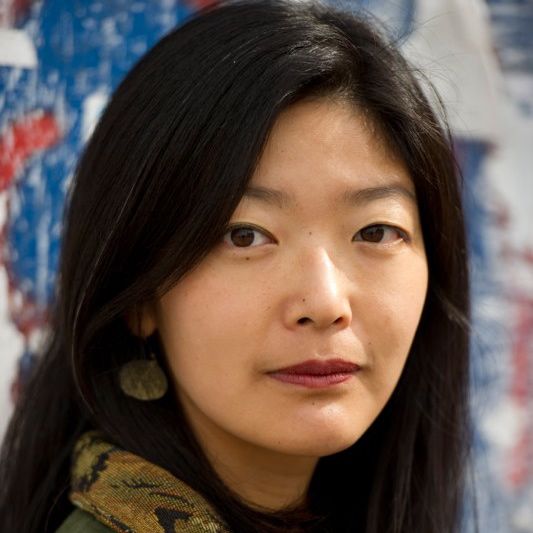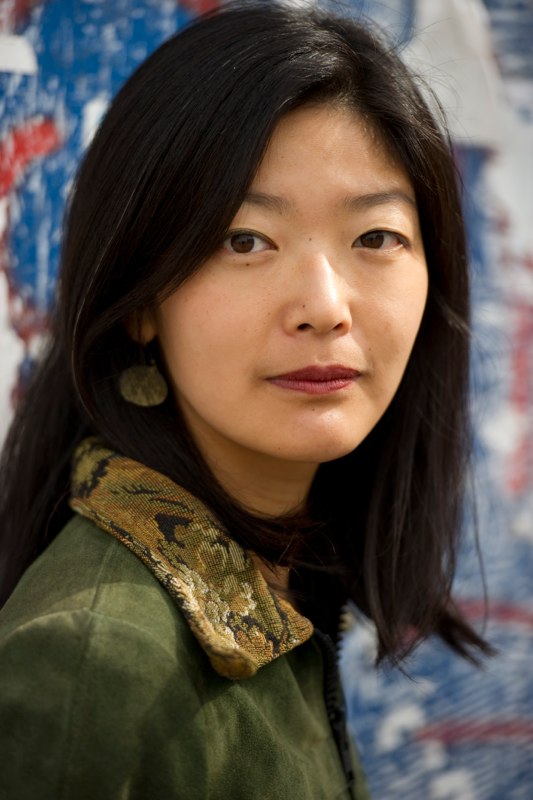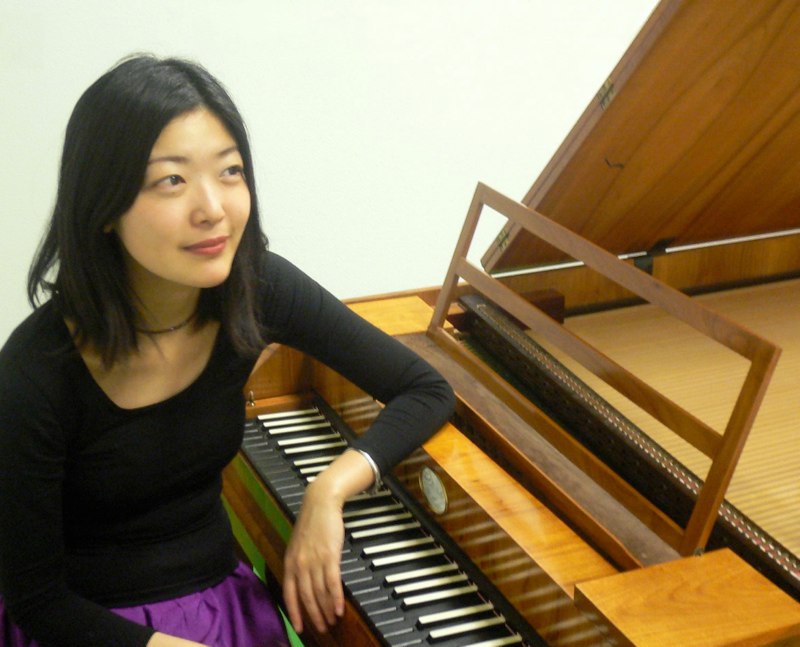Keiko Shichijo – piano: ‘En Amor Duro’ van Maria de Alvear
7 december 2014 | 16.45 uur
| Museum Geelvinck Hinlopen Huis,

Maria de Alvear : ‘En Amor Duro’
Over ‘En Amor Duro’
Maria de Alvear is a Spanish- German composer based in Cologne.
‘En Amor Duro’ is a vast, dramatic, meditative and spiritual piece for piano solo which is one of the very first piece she wrote in 1991, in the way of composition she calls ‘automatic writing’, which has neither structural plan nor logical architecture. “It really was written from pure love. It was the point that brought me together with my childhood. Suddenly I understood: there it was. It was a present. One afternoon I simply scribbled it down – and that was also a new beginning as far as writing music was concerned.” (quotes from de Alvear’s biography)
The inner essence of her work consists in creating protected open spaces (spiritual space, physical space, psychological space etc.) in which the performer and the audience can experience a profound freedom of being. Her music reaches out to many different levels of a persons mind and body which they can experience in an individual way.
| “Sound combinations can work on our state of mind as precisely as a surgical instrument, the change of one single note can cause a complete change in the state of mind and physical location in which a person has been before. The way these specific places work in connection with the individual state of a person and interact with a physical and spiritual reality is the foundation upon which Maria de Alvear bases her work.” (quotes from de Alvear’s biography) |
Keiko Shichijo
Pianist & fortepianist Keiko Shichijo is a special voice in both the Classical and New Music worlds. Her traditional Japanese sensibilities have combined with her knowledge of European historical performance practices to shape her unique vision, and this is reflected in her feeling for the music, the instruments and the story behind them.
Hailing from Japan but residing in the Netherlands for the past decade, she is a prizewinner in many international competitions, including twice the International Early Music Competition (solo and duo) in Brugge, Belgium, The International Early Music Competition “A Tre” in Trossingen in Germany and the Minkoff Prize from the music publisher, Edition Minkoff. Recent performances include the festivals Printemps Des Arts (France), Utrecht Oude Muziek Festival (Holland), MA Festival (Belgium) and Midis-Minimes (Belgium), a Mozart piano concerto with the Stradivaria orchestra, a historical setting of Schoenberg’s Pierrot Lunaire, a program of Satie at the Concergebouw Amsterdam with mezzo Antje Lohse and tours throughout India and Japan. In 2012 Hamamatsu Museum of Musical Instruments in Japan released her first fortepiano solo CD of works by Schubert.
Keiko Shichijo has worked with many composers, including Frank Nuyts, Frederick Rzewski, Tom Johnson, Lucio Garau and Anne La Berge. Recently she also gave the premiere performance with the Rotterdam Sinfonia of the first ever concerto for iPad and Orchestra by Ned McGowan.
Keiko Shichijo studied fortepiano with Prof. Stanley Hoogland and organ with Prof. Pieter van Dijk in Amsterdam Conservatory, and specialized contemporary music with Prof. Daan Vandewalle in Royal Conservatory of Ghent in Belgium.
Keiko Shichijo is active around the world playing both solo and chamber music.
xxxxxxxxxxxxxxxxxxxxxxxxxxxxxxxxxxxxxxxx
Pianiste en fortepianiste Keiko Shichijo is een bijzondere stem in de wereld van zowel de klassieke als de hedendaagse muziek. Zij verbindt een traditionele Japanse sensitiviteit met een grondige kennis van de Europese historische uitvoeringspraktijk. Dit leidt tot een unieke visie, die zich openbaart in haar gevoel voor de muziek, voor de instrumenten, en voor hun achterliggende verhaal.
Zij is afkomstig uit Japan maar heeft het afgelopen decennium in Nederland gewoond. In vele internationale concoursen heeft zij prijzen gewonnen, waaronder twee maal het internationale oude muziek concours van Musica Antiqua te Brugge (solo, en met duo), het internationale oude muziek concours ‘A Tre’ in Trossingen, Duitsland, en de Minkoffprijs van uitgever Edition Minkoff. Recent was zij te horen op onder meer het festival Printemps des Arts (Frankrijk), het Oude Muziek Festival te Utrecht, het MA Festival (België) en Midis-Minimes (België). Zij trad onder meer op in een pianoconcert van Mozart met het Stradivaria orkest, in een historische uitvoering van Pierrot Lunaire van Arnold Schoenberg, een Satie-programma in het Concertgebouw te Amsterdam in samenwerking met mezzosopraan Antje Lohse, en in tournees door India en Japan. In 2012 bracht het Hamamatsu Muziekinstrumentenmuseum in Japan haar eerste solo-CD op fortepiano uit met werken van Schubert.
Keiko Shichijo heeft met veel componisten samenwerkt, waaronder Frank Nuyts, Frederick Rzewski, Tom Johnson, Lucio Garau en Anne La Berge. Recentelijk bracht zij met Rotterdam Sinfonia de eerste uitvoering van het allereerste concert ooit gecomponeerd voor iPad en Orkest, van componist Ned McGowan.
Publeksreactie:
‘Het instrument bracht onder haar handen een puurheid aan klanken voort, werkelijk adembenemend. ‘Zo moet Mozart het zelf gespeeld hebben’ ging er door mij heen. Haar hele verschijning ademt puurheid, en zo ook de intensiteit van haar mimiek tijdens het spelen’. (anonymous uit het publiek)
Maria de Alvear – componiste
The composer Maria de Alvear was born in Madrid (Spain) in 1960. She studied music mainly in Spain and Germany: harpischord, organ, piano, conducting and composition.
Since 1998 she has regulary collaborated with her sister Ana de Alvear (visual artist), who has created photographic installations for performances of Maria de Alvear’s music.
In 1986 she completed a course in “Neues Musiktheater” with Prof. Mauricio Kagel at the Musikhochschule Köln. De Alvear´s work is interactive and based on a knowledge of energy connections. In every musical event (concert) she combines the power of visual art together with musical structure. To give an example: she creates an installation, placed around a chamber orchestra, using several different materials, such as salt, stones, branches or leaves, clothes, golden or coloured threads, or various sorts of video installations, depending on what the piece of music and the performing space suggest to her. She also performs and sings in her own pieces. The inner essence of her work consists in creating protected open spaces (spiritual space, physical space, psychological space etc.) in which the performer and the audience can experience a profound freedom of being.
Some of her pieces are based on themes that are taboo to our Western way of thinking, provoking vehement debates and interesting interactions as a response to her work. This means that De Alvear´s work is also a courageous dialoge with the establishment.
The involvement of spiritual qualities and energetic knowledge in her work demands a responsible deep understanding of the great power of music and art, a power that should be taken care of in a good, strong way.
Maria de Alvear has been very influenced by the trips she has made to different aboriginal nations in USA and Russia while looking for the inner essence of music and trying to understand the roots of musical development. Working intensively with Tsolagiu M.A. RuizRazo (Cherokee nation) and Rahkweeskeh (Tuscarora nation) has been very important for her. She feels they have been her most important teachers as regards the interaction between music and both physical and non-physical reality.
The extremely diverse levels on which her work functions simultaneously are very interesting. “Sound has the quality of putting a particular person’s mind and body in a specific place”. Sound combinations can work on our state of mind as precisely as a surgical instrument, the change of one single note can cause a complete change in the state of mind and physical location in which a person has been before. The way these specific places work in connection with the individual state of a person and interact with a physical and spiritual reality is the foundation upon which Maria de Alvear bases her work




